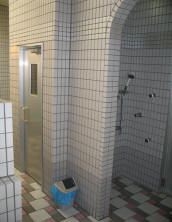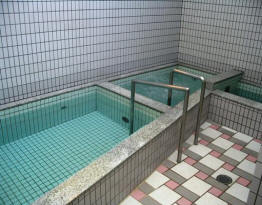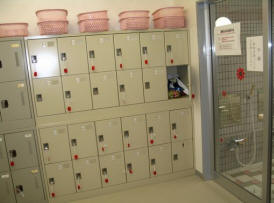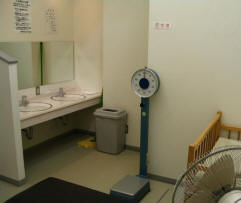
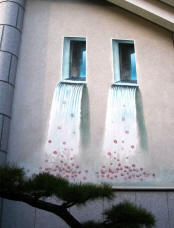
 THE ONSEN
Onsen or Japanese hot spring bath is the one thing that is all encompassing in our world
of biking around Japan. Without this little luxury, you can bet I would
think twice about bike/camping. But it is what makes it all worth the
miles and miles of pumping up hills and sleeping on the ground.
Difficult to describe this amazingly wonderful experience so I will say it like
it says in our Lonely Planet Guide.
THE ONSEN
Onsen or Japanese hot spring bath is the one thing that is all encompassing in our world
of biking around Japan. Without this little luxury, you can bet I would
think twice about bike/camping. But it is what makes it all worth the
miles and miles of pumping up hills and sleeping on the ground.
Difficult to describe this amazingly wonderful experience so I will say it like
it says in our Lonely Planet Guide.
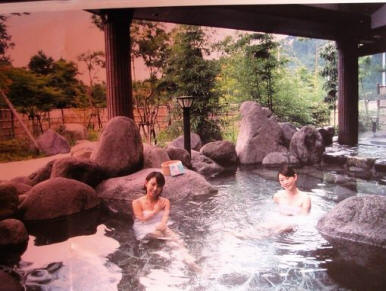
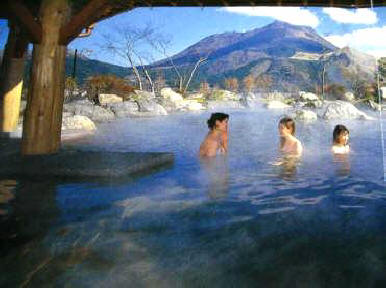 First know that getting naked with total strangers is not, for most of
us, the cultural norm, but shy gaijin (foreigners) should know that the
Japanese perceive bathing as a great social leveler: company presidents
rub naked shoulders with truck drivers, priests with publicans and all
revel in the anonymity that nudity allows.
First know that getting naked with total strangers is not, for most of
us, the cultural norm, but shy gaijin (foreigners) should know that the
Japanese perceive bathing as a great social leveler: company presidents
rub naked shoulders with truck drivers, priests with publicans and all
revel in the anonymity that nudity allows.

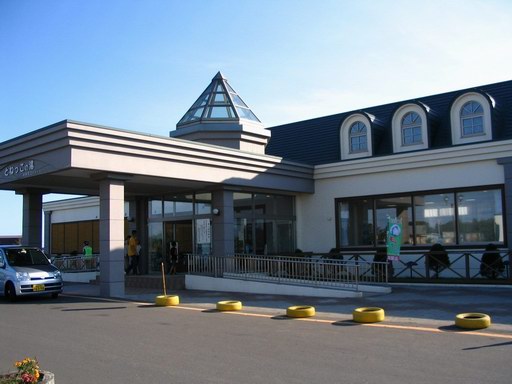
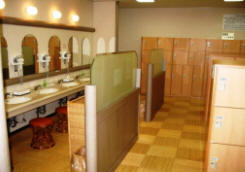 ONSEN ETIQUITTE
The Japanese
hot-spring O-FURO is blissfully free of the rules and regulations that make life
a minefield of potential societal gaffes for the average Japanese citizen.
No doubt this liberation from the strictures of polite society is what makes it
so popular. The first-time-naked gaijin needn't be intimidated once the
basics have been mastered.
Soap is a
commodity kept as far from the bath water as possible. Have a rinse in the
adjacent shower. If there's no shower, squat on one of the Lilliputian
stools provided and ladle hot water over your body, using one of the available
buckets, while outside the bath. Then gracefully ease yourself into the
water, Incidentally, stealing someone else's bucket or stool while
they are soaking is officially frowned upon but, in fact, seems to be an
undeclared national pastime.
ONSEN ETIQUITTE
The Japanese
hot-spring O-FURO is blissfully free of the rules and regulations that make life
a minefield of potential societal gaffes for the average Japanese citizen.
No doubt this liberation from the strictures of polite society is what makes it
so popular. The first-time-naked gaijin needn't be intimidated once the
basics have been mastered.
Soap is a
commodity kept as far from the bath water as possible. Have a rinse in the
adjacent shower. If there's no shower, squat on one of the Lilliputian
stools provided and ladle hot water over your body, using one of the available
buckets, while outside the bath. Then gracefully ease yourself into the
water, Incidentally, stealing someone else's bucket or stool while
they are soaking is officially frowned upon but, in fact, seems to be an
undeclared national pastime.
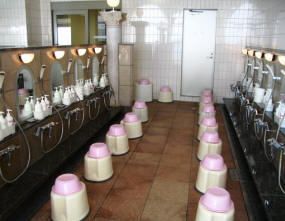
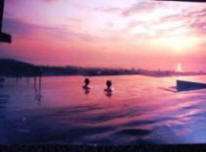
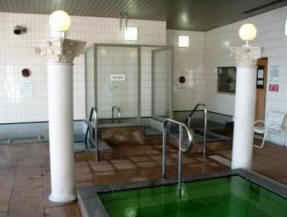 One should
endeavor to slip into the water with the minimum of disturbances, not unlike a
cherry blossom petal delicately slipping into a moonlit Kyoto temple pond.
Doing a double-pike with a half-somersault into the ornamental stone bath might
impress your traveling companions, but not only will it result in cerebral
hemorrhaging as you strike cranium to bath-bottom, it will mean instant social
death - blood in the bath water is a strict no-no.
In the event that
the water is hot enough to strip the skin off a rhino, it is perfectly
acceptable to do a reverse long-jump action, although if you can slowly ease
yourself into the superheated water, grimacing is positively encouraged.
If you accompany your facial contortions with a long drawn out anguished 'achee,
achEE, AAAcheeeee!" (hot, hooo-ot, HOOoo-ot), you will be considered a
professional.
An essential piece
of onsen equipment is a 'modesty' towel to delicately cover your most
private bits and pieces. Once they are safely underwater, this useful item
can be dipped in the water, rinsed out (outside the bath) and placed on your
head, a la Northern England male beachgoer, circa 1958. This is rumored to
prevent you from passing out (another minor social infringement). In the
more rural, single-sex baths, however, no one bothers with a modesty towel -
bathers wibble and wobble around, starkers as the day they were born.
It's that simple.
And if you do commit a faux pas, most people are too busy forgetting work and
looking forward to a night of karaoke to care.
And in the event that you
inadvertently FART, just try kyo tansan wa kitsui desu ne (CARBONATION'S STRONG
TODAY,ISN'T IT?)
One should
endeavor to slip into the water with the minimum of disturbances, not unlike a
cherry blossom petal delicately slipping into a moonlit Kyoto temple pond.
Doing a double-pike with a half-somersault into the ornamental stone bath might
impress your traveling companions, but not only will it result in cerebral
hemorrhaging as you strike cranium to bath-bottom, it will mean instant social
death - blood in the bath water is a strict no-no.
In the event that
the water is hot enough to strip the skin off a rhino, it is perfectly
acceptable to do a reverse long-jump action, although if you can slowly ease
yourself into the superheated water, grimacing is positively encouraged.
If you accompany your facial contortions with a long drawn out anguished 'achee,
achEE, AAAcheeeee!" (hot, hooo-ot, HOOoo-ot), you will be considered a
professional.
An essential piece
of onsen equipment is a 'modesty' towel to delicately cover your most
private bits and pieces. Once they are safely underwater, this useful item
can be dipped in the water, rinsed out (outside the bath) and placed on your
head, a la Northern England male beachgoer, circa 1958. This is rumored to
prevent you from passing out (another minor social infringement). In the
more rural, single-sex baths, however, no one bothers with a modesty towel -
bathers wibble and wobble around, starkers as the day they were born.
It's that simple.
And if you do commit a faux pas, most people are too busy forgetting work and
looking forward to a night of karaoke to care.
And in the event that you
inadvertently FART, just try kyo tansan wa kitsui desu ne (CARBONATION'S STRONG
TODAY,ISN'T IT?)

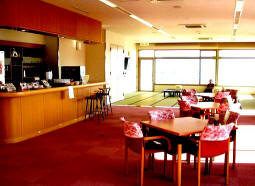

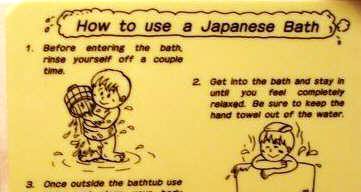 A sento is a
public bath house used mostly in local neighborhoods.
They
have existed for over 400 years in Japan, but a post-war construction
boom in residential housing without bathing facilities or running water
cemented the sento’s prominence in the community. Sento numbers are
dwindling today as Japanese can now afford baths or showers in their own
homes. The Yomiuri Weekly newspaper reports that sento's are disappearing
at the rate of one a day. Numbers peaked in 1964 at 23,016, but are
currently at 8,422. For a class-conscious society, the sento has become
an embarrassing reminder of an impoverished past, and as the ranks of
Japan’s noveuau riche have continued to swell, an undeserved stigma has
fallen upon those who patronize the humble sento; it has become the
domain of the shitamachi (inner urban areas) and the industrial “working
class” suburban sprawl. However, the sento remains a veritable oasis in
many communities, especially in the suffocating summers and brass-monkey
winters
A sento is a
public bath house used mostly in local neighborhoods.
They
have existed for over 400 years in Japan, but a post-war construction
boom in residential housing without bathing facilities or running water
cemented the sento’s prominence in the community. Sento numbers are
dwindling today as Japanese can now afford baths or showers in their own
homes. The Yomiuri Weekly newspaper reports that sento's are disappearing
at the rate of one a day. Numbers peaked in 1964 at 23,016, but are
currently at 8,422. For a class-conscious society, the sento has become
an embarrassing reminder of an impoverished past, and as the ranks of
Japan’s noveuau riche have continued to swell, an undeserved stigma has
fallen upon those who patronize the humble sento; it has become the
domain of the shitamachi (inner urban areas) and the industrial “working
class” suburban sprawl. However, the sento remains a veritable oasis in
many communities, especially in the suffocating summers and brass-monkey
winters

